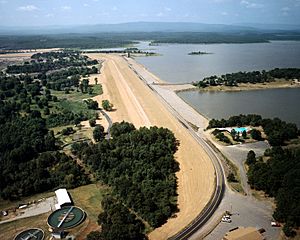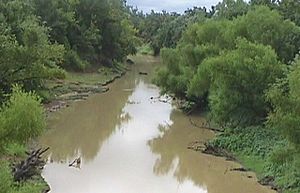Poteau River facts for kids
Quick facts for kids Poteau River |
|
|---|---|
| Country | United States |
| States | Arkansas, Oklahoma |
| Physical characteristics | |
| Main source | Waldron, Arkansas |
| River mouth | Fort Smith, Arkansas |
| Length | 141 mi (227 km) |

The Poteau River is a river that flows through Arkansas and Oklahoma. It is about 141 miles (227 km) long. This river is special because it's the only one in Oklahoma that flows north! It's also the seventh largest river in the state. The Poteau River eventually joins the Arkansas River, which then flows into the mighty Mississippi River. For a time, it even served as a border between parts of the Choctaw Nation before Oklahoma became a state.
Contents
What's in a Name?
The name Poteau comes from the French word for "post" or "stake." People believe French explorers named the river in 1716. A leader named Jean-Baptiste Bénard de la Harpe might have used a post to mark where the river met another. The nearby city of Poteau, Oklahoma got its name from this river.
Where the River Flows
The Poteau River starts near Bee Mountain in Waldron, Arkansas. It then travels north and west. The river meets the Arkansas River at Belle Point in Fort Smith, Arkansas. For a short distance there, it forms a border between Arkansas and Oklahoma.
River Branches
Smaller streams that flow into the Poteau River are called tributaries. Some of these include the Fourche Maline, Brazil, and Sans Bois Creeks.
Towns Along the River
Many towns are located along the Poteau River. In Oklahoma, these include Wister, Heavener, Poteau, Panama, Spiro, and Fort Coffee. The river also flows past Fort Smith in Arkansas.
Lake Wister: A River's Reservoir
Lake Wister is a large lake formed by building a dam on the Poteau River. This dam, called Wister Dam, was finished in December 1949. It's located about 70 miles (113 km) up the river from its mouth.
Lake Wister State Park
Around the lake, you'll find Lake Wister State Park. This park offers fun activities like boating, fishing, and camping. Both the lake and the dam are named after the nearby town of Wister, Oklahoma.
Mysterious Oklahoma Runestones
Did Vikings visit Oklahoma? Some people believe they did! Many runestones have been found in Oklahoma. Locals think these stones were left by Viking explorers. They might have traveled up the Mississippi and Arkansas Rivers to reach the Poteau River.
The Heavener Runestone
However, there isn't much strong proof for these claims. The most famous artifact is the "Heavener Runestone." You can see this stone at Heavener Runestone Park in Heavener, Oklahoma. It's a cool mystery to explore!


